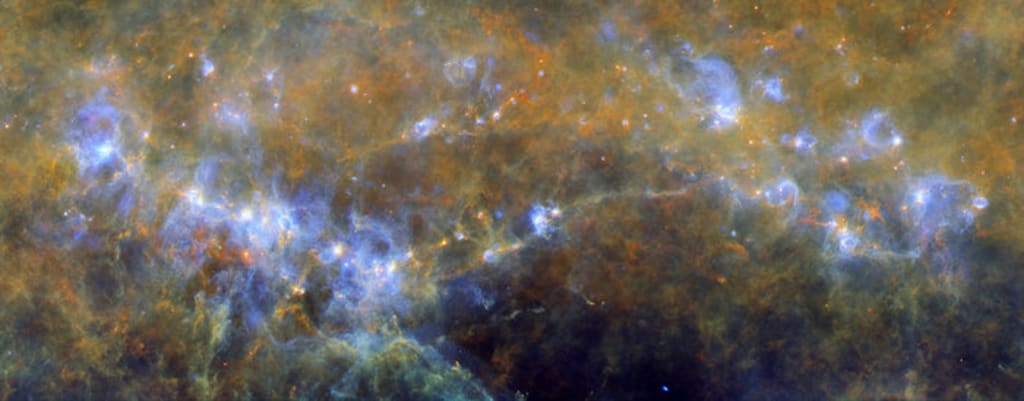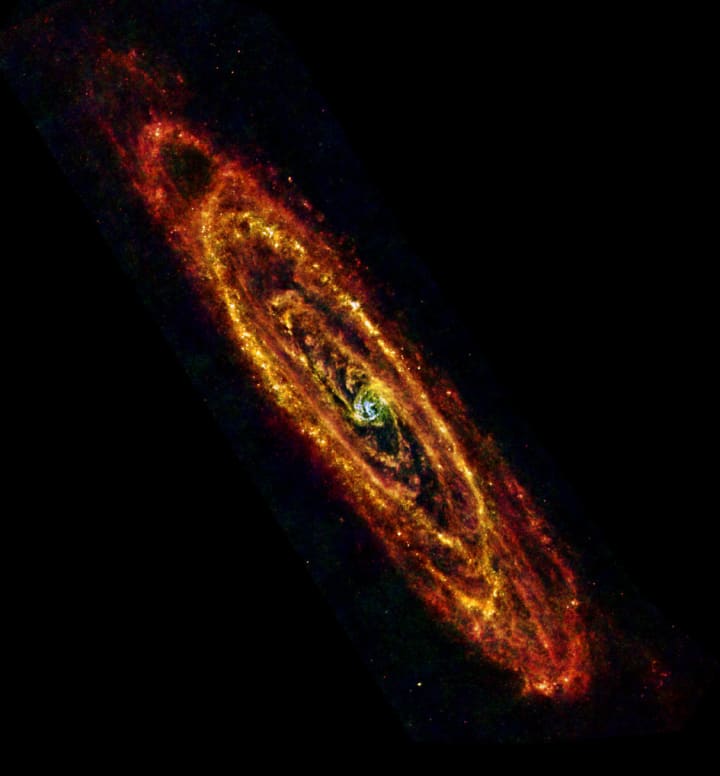Star Formation on Filaments in Molecular Cloud RCW106
The European Space Agency (ESA) has released today more images of star formation in the giant molecular cloud RCW106, a massive billow of gas and dust almost 12000 light-years away in the southern constellation of Norma, the Carpenter's Square.

The image above comes from ESA's Herschel Space Observatory, an ESA mission with participation from NASA. It was obtained as part of Herschel's Hi-GAL key-project, which imaged the entire plane of the Milky Way in five different infrared bands.
The Herschel Space Observatory is a space-based telescope that studied the Universe by the light of the far-infrared and submillimeter portions of the spectrum. It was launched in 2009 to observe the sky and scan the Milky Way with its infrared eye for almost four years.
Its mission was to reveal new information about the earliest, most distant stars, and galaxies, as well as those closer to Earth in space and time.
Herschel captured countless filamentary structures highlighting their universal presence throughout the Galaxy and their role as preferred locations for stellar birth.
Cosmic dust, a crucial ingredient in the interstellar material that pervades the Milky Way galaxy shines brightly at infrared wavelengths. Astronomers can easily explore stellar nurseries in detail by tracing the glow of dust with the infrared eye of Herschel.
And a star is born . . .
A closer look across the image shows dense concentrations of the interstellar mixture of gas and dust where stars are being born. The brightest portions, with a blue hue, are being heated by the powerful light from newborn stars within them, while the redder regions are cooler.
The delicate shapes visible throughout the image are the result of radiation and mighty winds from the young stars carving bubbles and other cavities in the surrounding interstellar material.
The furthest bright, blue region to the left is known as G333.6-0.2, and is one of the most luminous portions of the infrared sky. Its brightness is due to a stellar cluster, home to at least a dozen young and very bright stars that are heating up the gas and dust around them.
Elongates and thin structures, or filaments, stand out in the tangle of gas and dust, tracing the densest portions of this star-forming cloud. It is largely along these filaments, dotted with many bright, compact cores, that new starts are taking shape.
ESA released the video on April 22nd 2016. Bright sources, wispy filaments, and bubbling nebulas are shown against the background of diffuse gas and dust, marking the spots where stars are being born in the Galaxy.
Silence and beauty were compressed in just ten minutes by stitching together several hundred hours of Herschel observations obtained as part of the Herschel infrared Galactic Plane Survey. It spans almost 40% of the place of the Milky Way, where most of the stars in the Galaxy form and reside.
Our Galaxy, which is shaped as a disc of stars, gas, and dust has a diameter of about 100 000 light-years and the Solar System is embedded in it. The Solar System is about half-way between the center and periphery.
The view is a composite of the wavelengths of 70 microns (blue), 160 microns (green), and 350 microns (red).
Herschel: What's in a name?

ESA Herschel's Space Observatory: Cool image of Andromeda (M31). ESA released this image on January 28th 2013. Image: ESA
The Herschel Space Observatory was named for Britain's Sir William Herschel, who in 1800 discovered that the spectrum extends beyond visible light into the region that today we call "infrared."
At its launch in May 2009, Herschel was the largest infrared telescope sent into space. It focused light onto three instruments called HIFI, SPIRE, and PACS, which enabled Herschel to be the first spacecraft able to observe in the full 60-670 micron range.
Herschel's observations account to about 7,000 hours of science time per year of observation. Two-thirds of the time is available to the world scientific community, with the rest reserved for the spacecraft's science and instrument teams.
About the Creator
Susan Fourtané
Susan Fourtané is a Science and Technology Journalist, a professional writer with 18 years experience writing for global media and industry publications. She's a member of the ABSW, WFSJ, Society of Authors, and London Press Club.






Comments
There are no comments for this story
Be the first to respond and start the conversation.